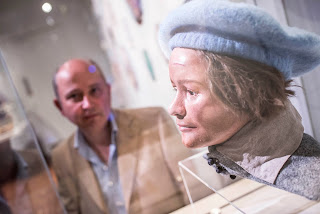Take a step through time and walk
in the shoes of the Scottish soldiers who became Durham’s darkest secret.
Laura Lindow has written a
powerful and poignant piece which transports the audience back into 17th
century Scotland and brings alive the heart-breaking tale of local lads who were
conscripted to fight against Cromwell’s English army and their families they
were forced to leave behind. Based on
the archaeological findings at Durham Palace Library, and using the forensic
evidence which helped to establish the soldiers’ lifestyle, Woven Bones is
clever, witty and captivating. Taking
the audience back from the initial discovery of the remains to the childhood of
one of the soldiers, we follow his story as he leaves the Western highlands and
walks down the length of the country, finally ending up at the battle of
Dunbar. From here, our soldier is
captured and becomes a prisoner of war, marched further south and held captive
with thousands others in Durham Cathedral.
Luckily, he was one of very few who survived and ended up leaving these
shores for a new life in a New World.
The cast, Greig Adam, Paula
Penman and Gemma Stroyan are brilliantly inventive, providing everything from
the soundscape of building work right through to becoming archaeologists providing
the science behind the soldier’s story. They
very quickly draw you into the world of Scottish families in the mid 1600’s
with a blend of humour and pathos. Director
Brad McCormick keeps the intensity high, made all the more claustrophobic by Katie
Doherty’s ambient soundtrack, while Anna Reid’s design is impressive in its
simplicity.
If you have been to see the Bodies
of Evidence exhibition at Durham Palace Library then Cap-a-Pie's Woven Bones is a brilliant
companion to the whole story. Laura
Lindow has once again written a piece of theatre which transcends time and
cultures and, by ensuring that it’s not just the story of the soldiers but also
their families we cannot ignore that each set of bones found represents a life amongst
lives.
Woven Bones is on tour in June and July - check out the Cap-a-Pie website for more details:
http://www.cap-a-pie.co.uk/woven-bones/
29th June, The Maltings, Berwick
3rd July. The Customs House, South Shields
5th July, Arts Centre Washington
6th & 7th July, Gala Theatre, Durham





